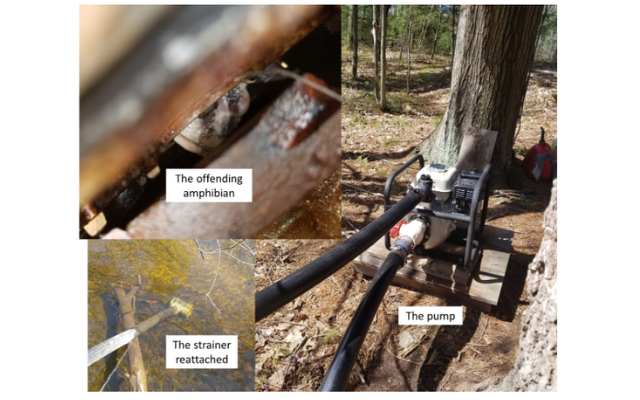This may sound like a strange bit of advice, but it is based on a real set of events. How could this possibly be the case?? Read on…
It all started with a move to the greater suburbs; in this case, to the pastoral country…an expanse of land bordered by a stream. A perfect place to have a home with a superlative garden. And superlative it indeed started. Way bigger than it was possible to take care of it and control the weeds, but wonderful nonetheless. This obviously needed watering, and with the stream nearby, it was just a basic problem of getting a pump to irrigate. What could be simpler?
A gas engine-powered pump and a huge two-inch black hose reel were purchased to get water out of the stream and direct it to the garden area. In case you have not worked with the coil of pipe, there is a reason why the hose is in the plastic family. It stays in one place until you change its shape, but it takes time. And a coil of two-inch pipe likes very much to stay in about a six-foot diameter coil. Getting it to lay flat turns out to be a struggle; warm weather being a help, cool weather a hindrance. As I struggled to uncoil the pipe through the woods by the stream, I felt like an adventurer battling a giant python in the jungle, but eventually, the irrigation system was laid down. Other than the tomatoes sampled by the local groundhog, the crop turned out spectacular. But the return on investment came out in the miserable category; adding the costs of the pump, the pipe, the fuel to run the pump, miscellaneous hardware, and a sprinkler, all the expenses contributed to make these the most expensive tomatoes ever to be produced. The few remaining tomatoes not gnawed on by the woodchuck, (or was that a ground hog? which I wanted by then to turn into ground chuck), were definitely most delicious.
But back to the pump. Over the years it performed well. Rodents did create problems. It seems that having the pump covered with a wooden box when not in use, did keep the weather out, but some rodents in. Some of them encountered a rotational demise as they built a nest in the engine fan, only to be accelerated beyond comfort on start-up. Others, having made a nest inside the volute after the pump was drained for the off-season, found themselves flooded as the pump was primed when spring returned. This led to another problem. Closing the ports in late Fall to keep rodents out, before the heavy frost set in, ended up having water from the pipe get back to the pump on a warmer day, and then freezing and cracking the case on a really cold night. It had been over a decade; a new pump was not a huge problem.
So, we finally get to the latest performance issue. No rodents, no freezing, but poor performance. What used to be a lively squirt from the irrigation pipe, (for the flower beds now), was just a miserable weeping. What could be the problem?
The first clue turned out to be that the strainer at the end of the suction pipe somehow got disconnected and the pipe was laying in the bottom of the stream. Suspecting something clogged the intake pipe, I separated it from the pump intake. As best as I could see, it was clear. Getting everything back together it did not seem to make any improvement. It was time for a more serious intervention. Reluctantly, fearing more problems to be created from what was somewhat working, it was time to open the pump casing.
Thankfully, no bolts broke off, and the casing separated cleanly. Then the problem became clear. A whitish object was stuck in the impeller suction. What could it possibly be?
In these days of general infection, caution is in order. A set of very long needle nose pliers was used to remove the object. Between disdain and repulsion, out came the obstruction. It turned out to be a mangled frog that must have been sucked through the suction pipe after the strainer got disconnected. The pump is now irrigating at its best. But this was most certainly a case of an amphibian ruining pump performance. So, make sure intake strainers are in place, and if your pump efficiency goes down, beware of amphibians!




